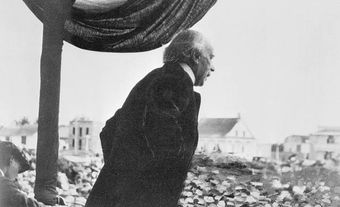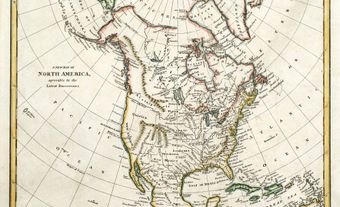The Oregon Treaty was an agreement between Britain and the United States. It came into force on 15 June 1846. It formalized the border between the United States and British North America west of the Rocky Mountains. It extended the border along the 49th parallel to the Pacific Ocean and down “the middle” of the channel that separates Vancouver Island from the mainland. The treaty resolved an important dispute between the two nations. But the lack of precision regarding the waterways between the mainland and Vancouver Island led to a dispute over the San Juan Islands, which resulted in an 1859 diplomatic conflict known as the Pig War.

Background
In the late 18th century, several imperial powers including Spain, Russia, the United States and Great Britain sought to control North America’s Northwest Coast. After 1824, only the United States, Russia and Britain maintained territorial claims in the region. Both Britain and the US claimed everything west of the continental divide from as far north as Russian Alaska to as far south as Mexico (which at that time included most of present-day California). This area was called the Oregon Territory by the Americans and the Columbia region by the British.
The Convention of 1818 resolved some territorial disputes stemming from the War of 1812 and earlier, and resulted in an agreement for both nations to jointly occupy and administer the territory for a period of 10 years. During that time, subjects of both nations would have their rights respected and would be free to trade and settle as they saw fit. Britain had a somewhat stronger claim to the region, largely due to the activities of the North West Company.
When talks between the two nations resumed, the Americans proposed a northern boundary at the 51st parallel; the British countered with an extension of the 49th parallel to the Columbia River. Britain wanted to retain the area north of the Columbia to preserve British commercial interests in the fur trade. However, these negotiations were inconclusive.
“54-40 or Fight!”
The issue remained unresolved until it became a political football during the 1844 US presidential election. Democratic Party candidate James K. Polk won the election on an expansionist platform, which included the annexation of the Republic of Texas.
There was considerable expansionist pressure on the Polk administration. Some American pundits argued that the rightful US claim extended as far as the border with Russian Alaska at latitude 54 degrees and 40 minutes. The popular slogan “Fifty-four Forty or Fight!” reflected the position of diehard expansionists that the United States should go to war with Great Britain if they proposed anything other than total American control of the region. (The slogan is also the namesake of the Vancouver band 54-40.)
An additional complication was the annexation of the Republic of Texas as a “slave state.” Annexing the Oregon Territory as a “free state” was considered necessary to maintain the balance of free states and slave states in the antebellum United States. (See also American Civil War and Canada.)

Signing the Treaty
Polk was under pressure to accept no compromises. But the annexation of Texas caused a rapid deterioration in Mexico-US relations. A war with Mexico was looming and the Polk administration knew that it could ill afford to engage in two simultaneous conflicts. So the Americans contacted British representatives to hammer out a deal.
The British were also disinclined to fight a war with the United States over this territory, so they agreed to the terms of the Oregon Treaty. (It was a modified version of an earlier American proposal.) The agreement extended the border along the 49th parallel to the Pacific Ocean but kept Vancouver Island within British North America. It was also agreed that British subjects living in the Oregon Territory south of the 49th parallel would retain navigation rights on the Columbia River.

The Pig War
The border dispute was not completely resolved by the Oregon Treaty of 1846. The wording of the treaty was vague when it came to the “channel which separates the continent from Vancouver Island.” Because there are several navigable waterways between Vancouver Island and the mainland, ownership of the San Juan Islands remained contested.
British and American settlers on San Juan Island (about 20 km northeast of Fort Victoria) had been suspicious of one another and involved in some minor disputes since 1855. But in 1859, a pig wandered from the British-Canadian side to the American side and was found in an American settler’s garden. The pig was shot, the British demanded compensation, and American troops were sent to occupy the island while British warships patrolled offshore.
Tensions remained high, but the conflict never escalated into an actual war. German Kaiser Wilhelm I acted as arbitrator and brought about a resolution; in 1872, the US was awarded the San Juan Islands. This officially completed the setting of the border between the US and British Columbia.
See also History of the Canada-US Border in the West; The Fraser River Gold Rush and the Founding of British Columbia; Alaska Boundary Dispute; Historical Boundaries of Canada.

 Share on Facebook
Share on Facebook Share on X
Share on X Share by Email
Share by Email Share on Google Classroom
Share on Google Classroom

![“Ho! For Frazer River” [sic]](https://d14fiu1i7ba797.cloudfront.net/340x207/media/new_article_images/FraserRiverGoldRush/512px-Peep_at_Washoe_-_Ho!_For_Frazer_River.jpg)

